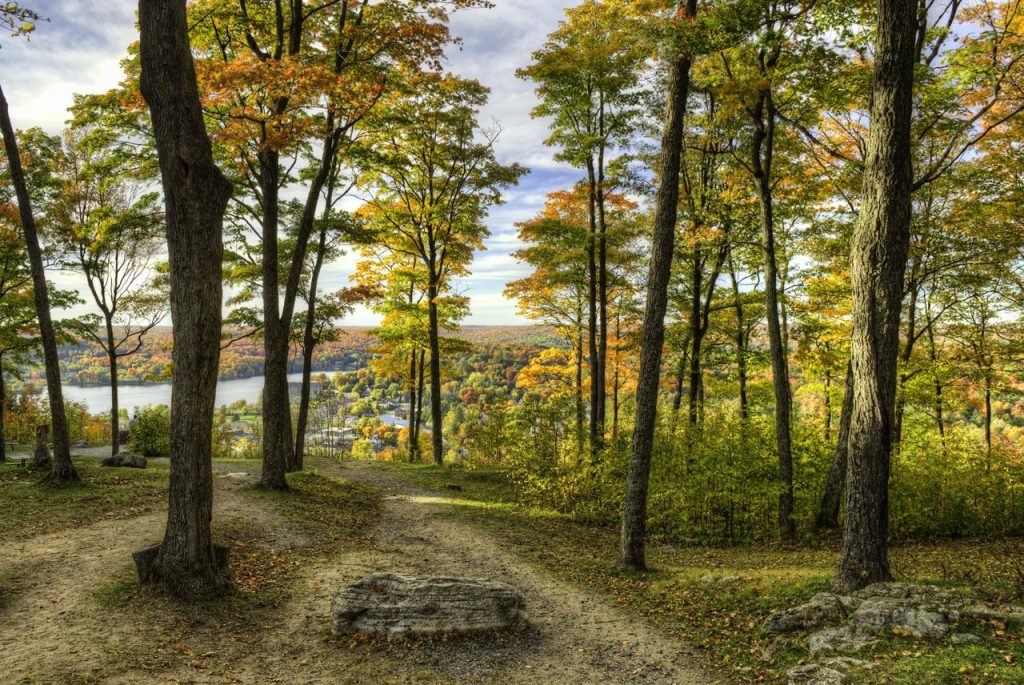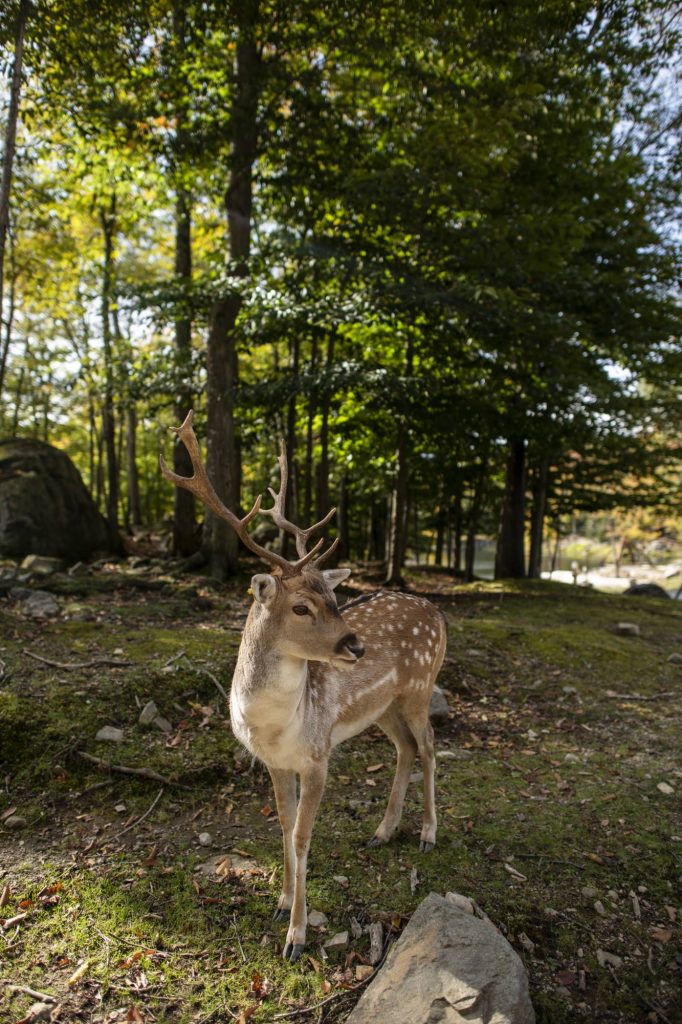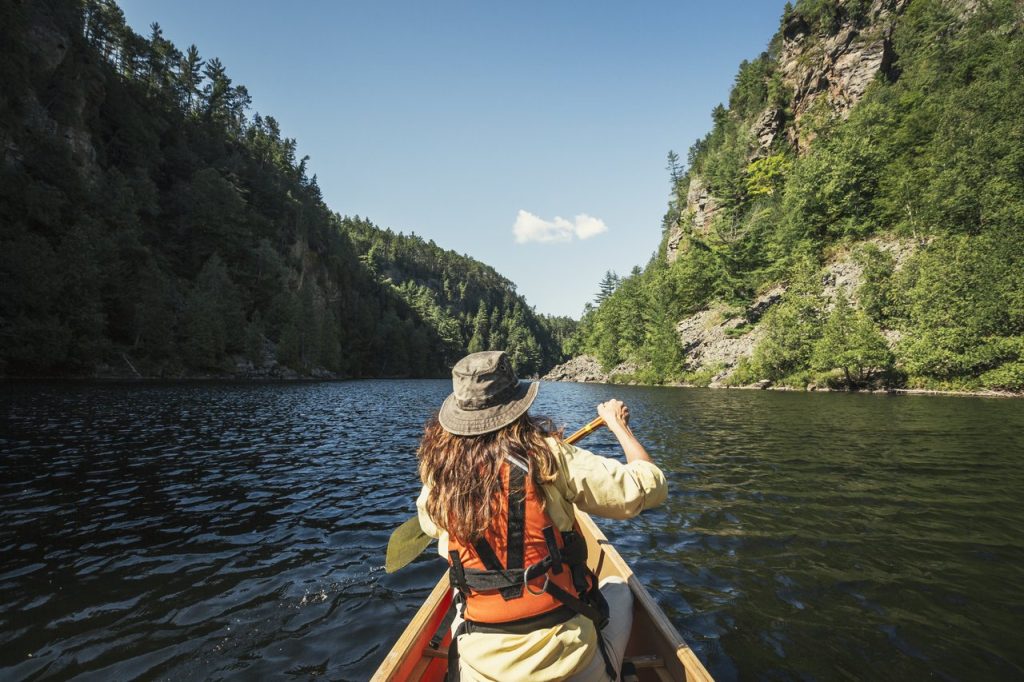The diversity of outdoor experiences in Ontario is staggering, and a draw for not only Canadians, but nature enthusiasts around the world. Considering the presence of over a quarter of a million (yes, you read that right) lakes, vibrant boreal forests, wetlands of all shapes and sizes, the striking Canadian Shield, and the Great Lakes shorelines, that’s no surprise. When you add in over 400 species of birds, and everything from moose to bears, wolves, turtles, lynx, otters, and even caribou and polar bears—there’s good opportunity for Ontario wildlife viewing regardless of which direction you’re headed in.
Listen to songbirds, be in awe of the moose gracefully wading through a lake, marvel at a family of beavers diligently constructing their dam, and spend a little more time on the shore’s edge amongst our turtles and frogs. These are the experiences that remind us to be in awe, and to appreciate that it’s never been more important to support initiatives which protect the wildlife that make this province so special.
Seeing wildlife in its natural habitat is an unforgettable Canada highlight—a country celebrated for its sprawling wilderness and immense natural spaces—etching itself into your memory long after the journey ends.
Useful tips for seeing animals in Ontario, Canada

Wildlife observation is all about intention, knowledge, and the right amount of patience. As Ontario Parks has publicly noted, you want to “let nature come to you,” and not the other way around. It’s critical that visitors remember that, ultimately, we’re visiting animals in their natural habitat and, as such, we need to have a certain mindset about how to do that as respectfully as possible.
If you’re visiting in the early spring, it’s moose you’ll want to keep an eye out for, whereas black bears, wolves, loons (yes, the bird that’s on our dollar coin!), and butterflies are more likely to be seen in the summer. Bald eagles can be seen year-round, and you’re most likely to set eyes on a beaver (at 32 kg a piece, they’re the largest member of Canada’s rodents) at dusk or dawn.
In terms of how to responsibly see Ontario wildlife in practice, here are some things to keep in mind:
- The best safety tip is obviously to to keep your distance, so that you’re not impeding the natural order of things. This is where binoculars, or having a camera with a zoom lens on it comes in handy.
- You’ll also want to be sure that you’re still and quiet, since wildlife are always on high alert.
- One of the cardinal sins of wildlife observation is feeding wild animals, so stay on the right side of that line, and also ensure that when you leave the park, you’re bringing all of your food with you, and that you leave “no trace.”
- This is especially crucial during nesting and mating season, but as a point of principle, be sure to stick to marked trails and boardwalks.
- Finally, you’ll want to keep your technology use to a minimum where you can, to be present during the experience. Field guides help, many of which you can find at park Visitor Centres, but you can also download apps like INaturalist or eBird to both track and understand your sightings better.
- Generally speaking, if it feels like your actions are affecting the natural movement of nature, that’s a sign you need to revisit some of the key ideas listed above that make for the ultimate Ontario wildlife viewing conditions.
Where can I see wildlife in Ontario and what wild animals live here?

Best places to watch wildlife in Northern Ontario
Northern Ontario has its own “wildlife corridor,” and each part of the region has its own draw, for its own reasons. This location is one of the most diverse places in North America as far as wild animals are concerned. Generally speaking, though, this where wildlife enthusiasts get up-close-and-personal with some of the province’s largest and most majestic creatures.
In the far north, you’ll find the Cochrane Polar Bear Habitat, a research, wildlife and conservation station that sits on nearly 10 hectares of a subarctic and boreal landscape, beside a pristine lake. There are opportunities to do photography tours, to take a behind the scenes tour, and understand how crate training works with polar bears, and even do some overnight camping!
Another experience in that vein is the chance to stay at Cedar Meadows, and to “sleep with the wolves.” You’ll be safe and sound in their cozy accommodations, but those accommodations have views directly into the wolf reserve. The park is also home to a healthy population of bison, elk, and fallow deer.
Bird enthusiasts will want to circle the Hillardton Marsh Research & Education Centre, especially during the spring and fall migration, to see a variety of birds native to the province, including songbirds, shorebirds, and hummingbirds.
Big time adventurers will want to note that if you’re willing to make it Moosonee from the Hudson Bay Watershed, you can see bearded seals and beluga whales in the spring and fall.
Each provincial park will have its own wildlife viewing potential, and at Ivanhoe Lake Provincial Park, there’s the potential to see moose, and even “white moose” or “ghost moose.” Moreover, Chapleau Crown Game Preserve is the largest crown game preserve on the planet, and its a prime spot to see waterfowl, moose, foxes, wolves, beavers, black bears, and owls in Ontario.
For the ultimate lookout point and a chance to put into perspective just how vast and beautiful wildlife observation can be, consider visiting Sleeping Giant Provincial Park near Thunder Bay, and hiking to the “Top of the Giant.”
Best places to watch wildlife in Central Ontario
The big park you need to have on your list here is Algonquin Provincial Park, arguably Ontario’s most famous destination for Ontario wildlife viewing. There’s a good chance you’ll get to tick a few of these little guys off your bucket list. You can take multi-day paddle or guided canoe trips, hike, or simply book a campsite to take it all in. Moose are the big draw in the spring, but you’ll see it all here (though no polar bears—that’s reserved for the north!). In late summer, keep your ears out for wolf howls!
The Georgian Bay Biosphere, a location of Ontario comprising over 30,000 islands with some awfully striking rugged shorelines, is a prime place to spot bald eagles, but also turtles, snakes, and a variety of frogs.
The Deer Yard, located just north of Muskoka, is your destination to spot white tailed deer, the Wolf Centre at Haliburton Forest offers you the chance to appreciate a large indoor observatory overlooking a forested enclosure (with an opportunity to stay overnight), and the Wye Marsh Nature Centre, not far from Midland, Ontario, is your spot to see trumpeter swans, birds of prey, and turtles aplenty.
Near Campbellville, if birds of prey, owls, hawks, eagles, and falcons are your forté, then you can’t miss the Mountsberg Raptor Centre.
Best places to watch wildlife in Southern Ontario (including Toronto)
If you’re heading south, why not visit the southernmost point on mainland Canada – Point Pelee National Park? Beyond its striking natural beauty (and impressive observation point), this is one of the province’s top spots for Ontario wildlife viewing. Nearly 350 species of birds pass through on their migratory journey, and it’s likely the best place to catch sight of the monarch butterfly. Birdwatching is at its peak in spring and fall, while your best chance to see the monarchs is around mid-September.
For photographers, the birds-in-flight workshops at the Canadian Raptor Conservancy are first class, with falcons, owls, vultures, eagles and hawks all on site.
Long Point Provincial Park should also be on your radar, as it’s part of a UNESCO designated World Biosphere Reserve, a great spot to see migratory birds, herons, frogs, songbirds and even coyotes. The sandy beach certainly doesn’t hurt either, if you’ll be visiting in the warmer months.
The Aquatarium at Tall Ships Landing is all about helping visitors engage with river species, with the most famous draw being their river otters.
Wainfleet Bog, near NIagara, is the largest remaining bog in Southern Ontario, where you can walk along boardwalks to get those lush bog views. You’ll also find boardwalks at locations like Presqu’ile Provincial Park.
Finally, it’s worth noting that being in a big North American city doesn’t preclude you from wildlife viewing. There’s great opportunity to see urban wildlife galore in the Toronto Region at spots like High Park, Tommy Thompson park, and Rouge River Urban Park.
Ontario’s wildlife awaits

An excuse to be present in today’s world is a gift in many ways, and that’s the heart of what it means to respectfully engage with Ontario’s wildlife. You take a deep breath and let things unfold on their own terms, paying attention to the little details that we so often miss when we’re drowning in our phone’s never-ending stream of notifications.
Ontario wildlife viewing offers exactly that: a rare chance to slow down and reconnect with something bigger than ourselves.
North America’s wide expanses offer a unique and intimate connection with the wild heart of the land, creating stories you’ll recount for years to come—a vivid reminder of the raw beauty and untamed spirit that defines this part of the world.



